Pulsars are a type of neutron star. They appear to blink similarly to a lighthouse. They appear to flicker because they spin very fast, and emit accelerated particles through their magnetic poles.
Key Facts & Summary
- A Pulsar is a core of a star that has collapsed into a neutron star.
- Pulsars spin very rapidly and have strong magnetic fields.
- A Pulsars powerful magnetic field produces a thin yet strong beam of electromagnetic radiation that is shot into space.
- This is actually what causes the repeating pulse pattern. Because of this, we seem them as blinking in the sky.
- Not all neutron stars are Pulsars, but all Pulsars are neutron stars.
- Within the Milky Way galaxy, there are around 2.000 pulsars.
- Each Pulsar has a unique spin rate and radial pulse profile.
- Some Pulsars spin so regularly that they’re used as timers by astronomers. Some Pulsars have such accuracy in keeping time that they are similar to an atomic clock.
- Pulsars have greatly helped us in detecting gravitational waves, probe the interstellar medium, and even find extrasolar planets in orbit.
- The discovery of the Pulsar – PSR B1257+12- which occurred in 1992, also led to the discovery of the first extrasolar planets.
- Currently, there are three distinct classes of Pulsars: Rotation-powered pulsars, Accretion-powered pulsars, and magnetars.
- Millisecond pulsars or MSP, refer to pulsars that have rotational periods in the range of about 1 to 10 milliseconds.
- Pulsars were first discovered in 1967 by Jocelyn Bell. At first, there were many speculations about them, leading to theories regarding extraterrestrial life.
- A pulsars magnetic field is usually trillions of times stronger than Earth’s.
- Their powerful magnetic fields are actually high-energy particle accelerators. Some are so powerful that they generate relatively bright gamma-ray radiations.
- There should be around a billion neutron stars in the Milky Way. This should mean that many more neutron stars of the pulsar subclass should exist. Since pulsars fade to near invisibility with age and most young pulsars have narrow lighthouse beams, better technology is needed in order to find such elusive objects.
Initially, pulsars were named with letters of the discovering observatory followed by their right ascension. Too many were discovered and this methodology was replaced with a new convention.
The letters PSR – Pulsar Source of Radio – followed by the pulsar’s right ascension and degrees of declination became the new norm in naming pulsars.
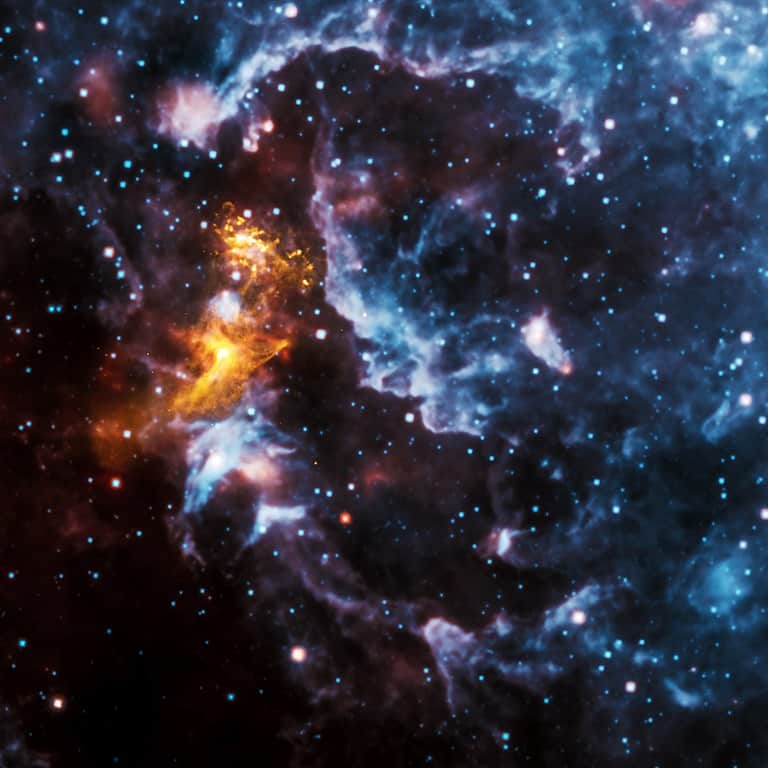
The discovery of pulsars happened in 1967. Astronomers Jocelyn Bell and Anthony Hewish observed on the 28th of November –pulses that were separated by 1.33 seconds. They originated from the same location in the sky.
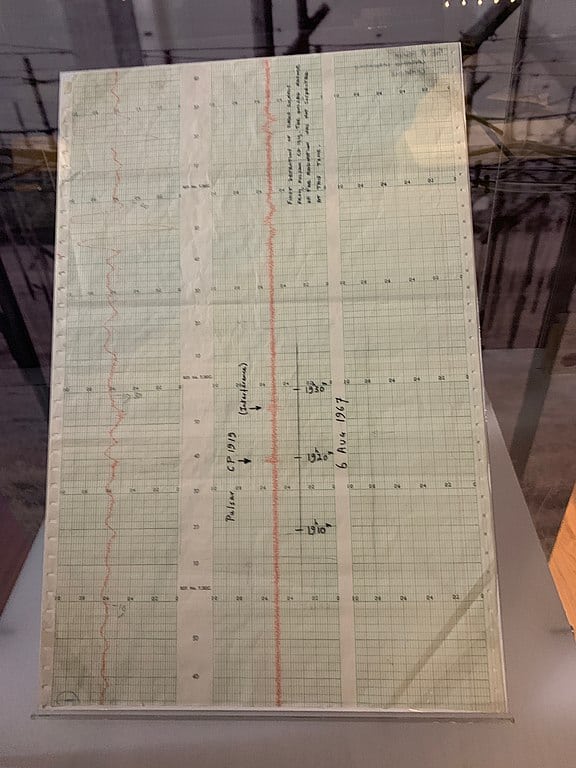
Due to its nature, many theories were thrown away – such as human-made frequency interference. As another telescope confirmed the same emissions, the astronomers believed, at first, that they were signs from another civilization.
They nicknamed the signal LGM-1, for “little green men.” This hypothesis was later abandoned as another signal was discovered. The actual name of the pulsars is now PSR 1919+21 and PSR J1921+2153.
The word “pulsar” is a blend of the words “pulsating” and “quasar.” It appeared for the first time in the printing press one year later, in 1968. As further observations were conducted and the celestial object began to be more understood, Hewish was awarded the Nobel Prize in 1974. This was controversial since Bell made the initial discovery while she was his Ph.D. student.

Formation
When a star nears the end of its life its core runs out of fuel for its fusion reaction, creating a supernova. The core collapses very rapidly to a very small size while huge amounts of energy are given off. This energy throws out the star's outer layers into space.
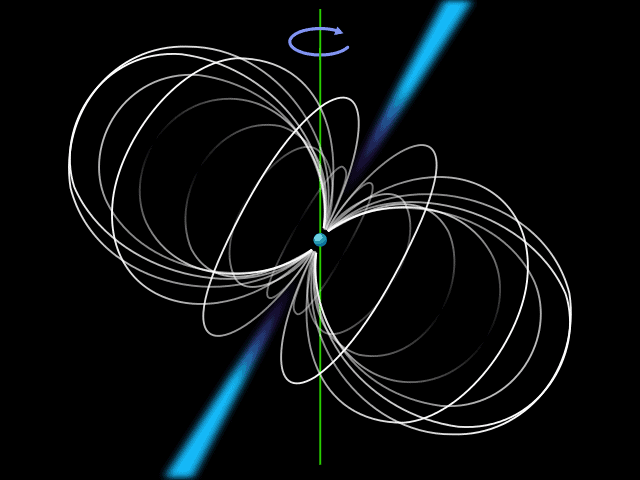
If such a star had the right amount of mass – around 8 to 20 times the mass of the Sun – it will either collapse to a neutron star or possibly a black hole. The core will then start to spin rapidly due to conservation of angular momentum.
The magnetic field of the star will be compressed along with it, resulting in powerful magnetic fields that rotate along with the star. As it does that, powerful beams of electromagnetic radiation are produced which is then shot out of the north, and south magnetic poles of the star.
Characteristics
Generally, the direction of the radio beam emitted by the Pulsar’s poles is not along the same axis that the Pulsar is spinning on. As the Pulsar rotates, its beams will point in different directions in the sky.
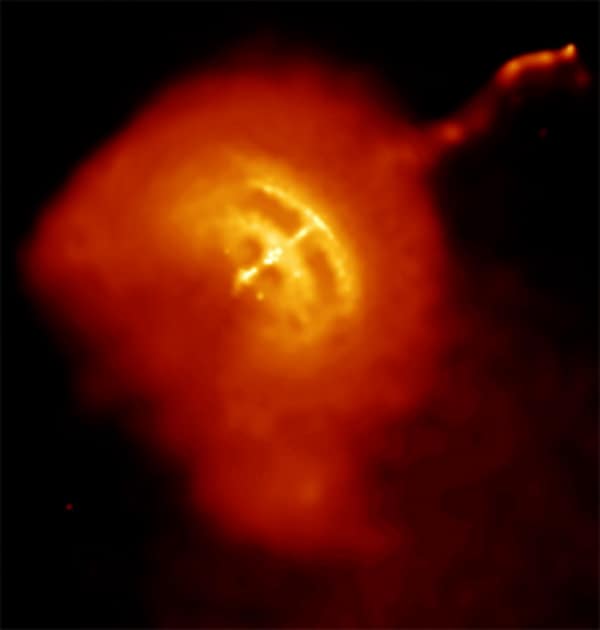
Since Pulsars don’t shine like other stars, if its radio beam isn’t pointed directly towards Earth, they are difficult to spot. If the radio beam is pointed directly at us, its rotation will be seen as little bursts of radio waves for short periods of time – it will appear as though the star is blinking.
Classification
Currently, there are only three classes of pulsars known to us. They are separated based on their source of power, their electromagnetic radiation:
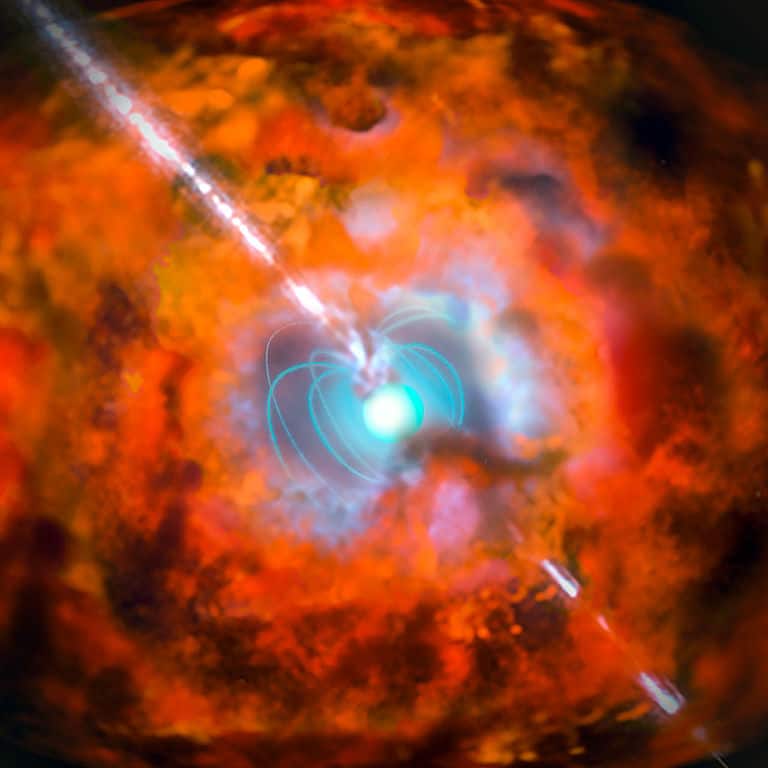
* Rotation-powered Pulsars – The loss of rotational energy of the star provides the power.
* Accretion-powered Pulsars – Most X-ray pulsars are in this category. The gravitational potential energy of accreted matter is the power source of these objects. They produce X-rays that are observable from Earth.
* Magnetars - The decay of an extremely powerful magnetic field provides the electromagnetic power.
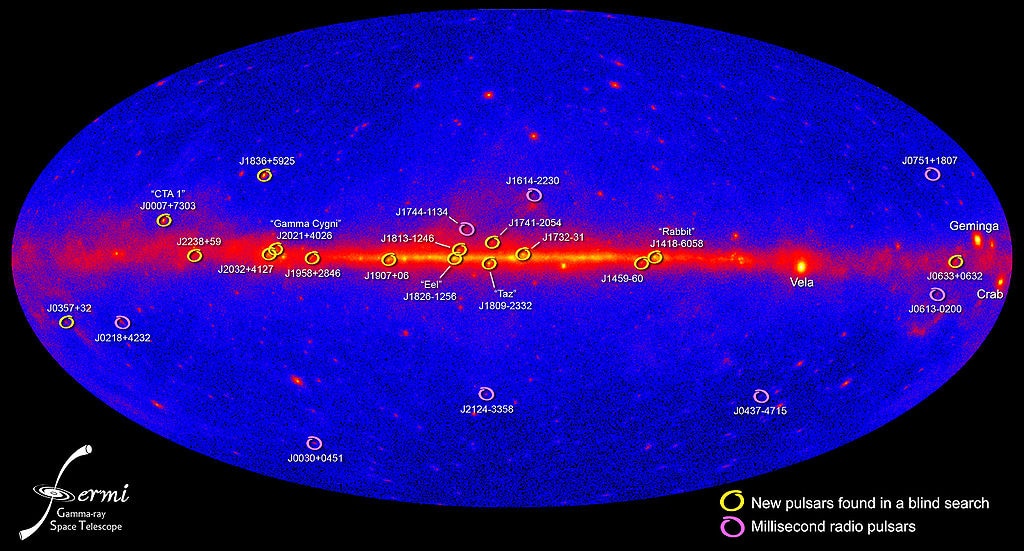
Though all three classes are neutron stars, their observable behavior and the underlying physics are quite different but also do share connections. X-ray pulsars are one of the oldest rotationally-powered pulsars.
They have lost much of their power and became visible again after their binary companions had expanded and begun transferring matter on to them.
This process of accretion can transfer enough angular momentum to the neutron star in order to “recycle” it as a rotation-powered millisecond pulsar. This process, however, leaves the millisecond pulsar’s magnetic field 1.000 to 10.000 times weaker than average pulsars.
Millisecond pulsars tend to live for billions of years thus they are the oldest known pulsars. Many of them have been discovered in globular clusters, which long since stopped their neutron star formation for billions of years.
Examples of Pulsars
Many pulsars have unique characteristics. Such as their pulse periods which often differ from one another. The first binary pulsar discovered, PSR 1913+16 has a decaying orbit of an exact rate. This is due to emissions of gravitational radiation by general relativity.
The brightest radio pulsar, currently known, is named the Vela Pulsar. It is associated with the Vela Supernova Remnant in the constellation of Vela.
The first discovered millisecond pulsar is PSR B1937+21. It is located in the Vulpecula constellation while the brightest millisecond pulsar, PSR J0437-4715 is also the closest to us. It is located in the Pictor constellation.
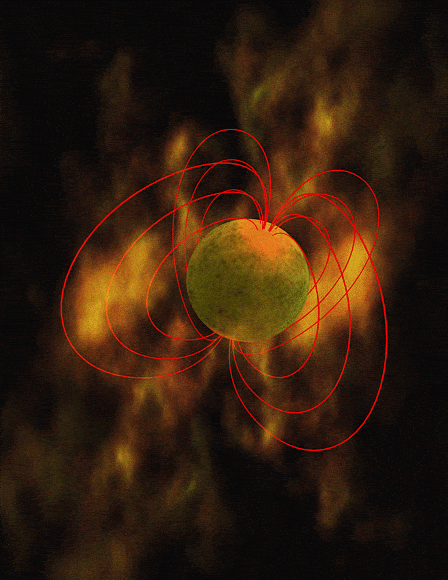
PSR B1257+12 is the first pulsar with planets, located in the Virgo constellation at around 2.300 light-years away from us. Another odd pulsar is the PSR J0737-3039, which is the first double pulsar binary system to be discovered.
The pulsar with the shortest period discovered is currently PSR J1748-2446ad, it has a period of ~0.0014 seconds / 1.4 milliseconds. It rotates 716 times a second.
The pulsar with the longest period currently known, as well as the first known example of a white dwarf pulsar is AR Scorpii. It has a period of 118.2 seconds.
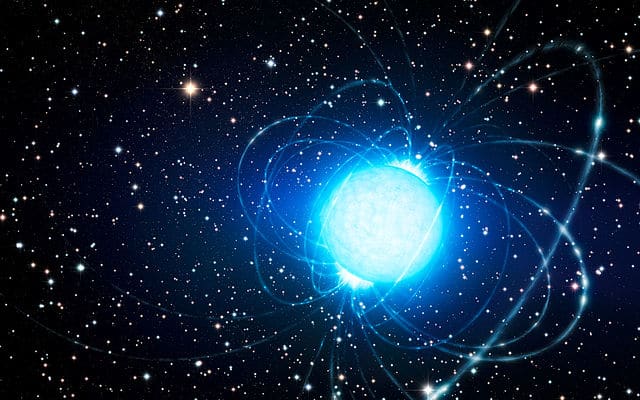
The Future
Pulsars remain closely studied by the scientific community. Though few have been found they display many unique characteristics. They have many applications such as their emissions that rival the atomic clock, probes of the interstellar medium and space-time, as well as acting as gravitational waves detectors.
Did you know?
- We can actually listen to the pulse profiles of Pulsars. To fully grasp the intensity of their spinning power, many audio files are available online to listen to.
- Some Pulsars spin so fast – more than 100 times per second – that we actually hear a single tone while listening to them.
- Pulsars have a turn-off mechanism. When the pulsar’s spin period slows down sufficiently it turns off. It is believed that this turn-off takes place around 10 to 100 million years.
- If the turn-off hypothesis is true, this means that all of the neutron stars born in the 13.8 billion year age of the universe, or at least 99% of them, no longer pulsate.
- The discovery of pulsars ultimately led to the discovery of neutron stars.
- Millisecond pulsars have allowed a test of general relativity in conditions of an intense gravitational field.
- One pulsar designated PSR J1841-0500 stopped pulsating for 580 days. It is only the second known pulsar that stopped pulsating for more than a minute.
Sources:
Image source:
- https://upload.wikimedia.org/wikipedia/commons/thumb/a/a6/PIA18848-PSRB1509-58-ChandraXRay-WiseIR-20141023.jpg/768px-PIA18848-PSRB1509-58-ChandraXRay-WiseIR-20141023.jpg
- https://upload.wikimedia.org/wikipedia/commons/thumb/6/65/Chart_Showing_Radio_Signal_of_First_Identified_Pulsar.jpg/576px-Chart_Showing_Radio_Signal_of_First_Identified_Pulsar.jpg
- https://upload.wikimedia.org/wikipedia/commons/thumb/c/c9/Chandra-crab.jpg/768px-Chandra-crab.jpg
- https://upload.wikimedia.org/wikipedia/commons/thumb/3/3e/Pulsar_schematic.svg/640px-Pulsar_schematic.svg.png
- https://upload.wikimedia.org/wikipedia/commons/1/1d/Vela_Pulsar_jet.jpg
- https://upload.wikimedia.org/wikipedia/commons/thumb/f/fb/Fermi%27s_Gamma-ray_Pulsars.jpg/1024px-Fermi%27s_Gamma-ray_Pulsars.jpg
- https://upload.wikimedia.org/wikipedia/commons/thumb/b/b0/Artist%E2%80%99s_impression_of_a_gamma-ray_burst_and_supernova_powered_by_a_magnetar.jpg/768px-Artist%E2%80%99s_impression_of_a_gamma-ray_burst_and_supernova_powered_by_a_magnetar.jpg
- https://upload.wikimedia.org/wikipedia/commons/d/d6/Magnetar-3b-450x580.gif
- https://upload.wikimedia.org/wikipedia/commons/thumb/e/e9/Artist%E2%80%99s_impression_of_the_magnetar_in_the_star_cluster_Westerlund_1.jpg/640px-Artist%E2%80%99s_impression_of_the_magnetar_in_the_star_cluster_Westerlund_1.jpg
